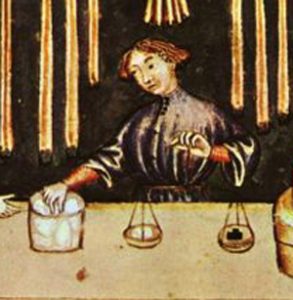
History of sugar: Sugar also has a lot of carbohydrates
History of sugar in the Islamic Empire
When the Abbasid army conquered northern India about 750 AD, the troops brought back sugar cane to the rest of the Islamic empire.
(More about where sugar comes from)
Maybe the climate changes of the Medieval Warm Period encouraged West Asians to try this new crop. Sugar soon reached North Africa and Spain, because they were part of the Islamic Empire. Sugar was a big hit. Farmers began to grow sugar cane all over West Asia and Egypt.
Islamic engineers invented new sugar cane presses to get more juice out of the sugar cane. Islamic traders also brought sugar to the east coast of Africa, as far south as Zanzibar, and possibly also across the Sahara desert to West Africa.

History of sugar: Selling sugar in medieval Europe(Theatrum sanitatis, codice 4182 della R. Biblioteca Casanatense. Rome, ca. 1375 AD)
History of sugar in Europe
Europeans were too poor to buy much sugar in the Early Middle Ages. But as the wool industry got going again in the 1100s AD, Europeans got richer. Venetian traders started to buy more sugar (along with Indian spices like pepper and cinnamon) from Fatimid Egypt to sell in Europe.
The English word “sugar” comes from the Indian word “sakkara”, and the English word “candy” comes from the Arabic word for sugar, “qand”, from the Indian word “khanda”, meaning “lump”.
Sugar production in Egypt
The Fatimids produced more and more sugar in the 1100s. Salah al-Din and the Ayyubids produced even more sugar in the 1200s AD, building water-mills to grind it.

History of sugar: Sugar mill at Tawaheen es-Sukkar, Palestinian Territories
But Egyptian sugar production ran into trouble in the 1300s under the Mamluks.
(More about the Mamluks)
Many Egyptians died of the bubonic plague (the Black Death). Nomads destroyed many sugar mills in Upper Egypt. The Mamluk government didn’t do a good job organizing trade, and as sugar got more expensive, Egyptian producers paid their workers less and cheated on the quality.
Europeans start to grow sugar
Europeans, tired of buying expensive, bad quality Egyptian sugar, began to try to grow sugar cane closer to home. Sugar cane wouldn’t grow in Northern Europe, but Europeans grew sugar in Cyprus, and in southern Spain, and in the Canary Islands.
Europeans force slaves to produce sugar
European manufacturers developed cheaper ways to make better sugar. For one thing, they used slave labor (paying workers even less than Egyptians did!). Sugar cane needed a lot of workers to harvest it and crush it, so the Europeans began to force people from the Black Sea area and from West Africa to work as slaves on the sugar cane farms.
(More about the history of slavery)
By the 1400s, Europeans had turned the market around and were selling sugar to Egypt and West Asia. Even so, sugar was still expensive in Europe, and only richer people could afford it.
Learn by doing: making sugar candy
Sugar, slavery, and colonization
Bibliography and further reading about sugar:




